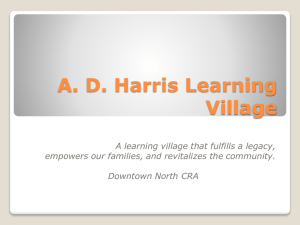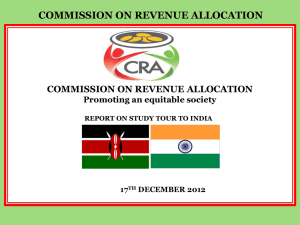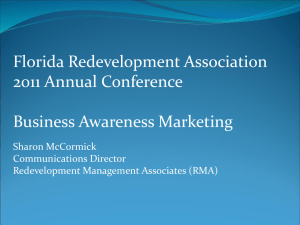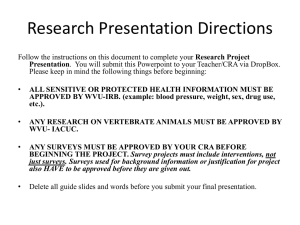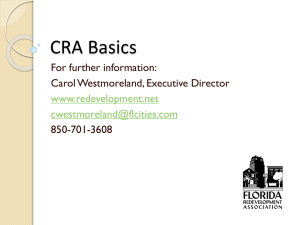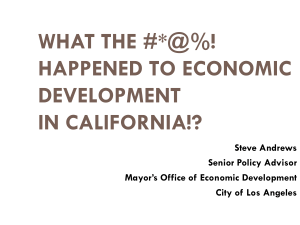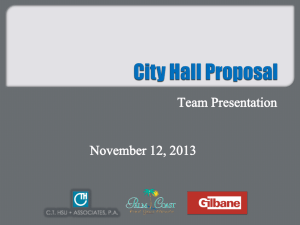OCT-2013-Terrell-s-CRA-Basics-Integrated
advertisement
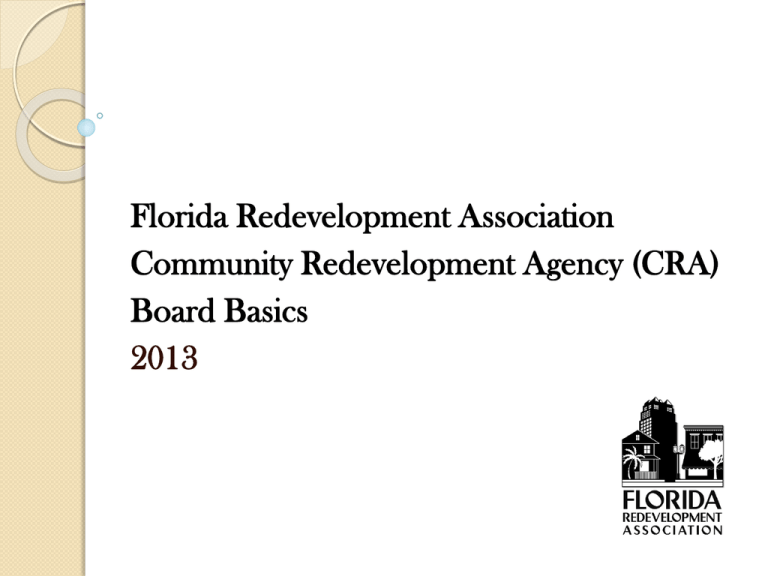
Florida Redevelopment Association Community Redevelopment Agency (CRA) Board Basics 2013 Agenda Why Redevelopment? What are Community Redevelopment Agencies (CRAs)? What can CRAs Do and Not Do? What are the “Rules of Engagement”? How to be an effective CRA Leader What are the Best Practices? 2 Ten Reasons to ‘Re’develop Remove Slum & Blight Create Clean and Safe Places Prevent Crime Encourage Economic Development Build or Enhance Affordable Housing Fund Streetscape and other Capital Improvements Preserve Historic Buildings/Resources Retain and Recruit Business Enhance Parks and Recreation Increase the Tax Base 3 What is Redevelopment? ANY activity authorized under Chapter 163, Part III, Florida Statutes. Relative to your CRA, activities are authorized by your approved Redevelopment Plan and funded by the increase in assessed values over time, called increment. 4 What is a CRA? Dependent Special District Created to remove slum and blight conditions within a designated district Board Members appointed by local government – elected officials or appointees or both Law generally says only one Community Redevelopment Agency (Board) per jurisdiction ◦ Exception - Charter Counties <1.6 million people CRA may have multiple CRA districts 5 Community Redevelopment Agencies (CRAs) Authorization for CRAs was passed in the Redevelopment Act of 1969 which became Chapter 163 Part III of the Florida Statutes Not in widespread use until after 1980 when State of Florida v. Miami Beach was decided As of last review there are 214 CRA Districts registered with the Florida Department of Economic Opportunity Currently the only form of Tax Increment Districts in widespread use in the State of Florida CRAs may be created by a City or County to assist in the elimination of slum and/or blighting conditions State is not involved in the creation of CRAs 6 CRA Legislative Intent Eradication of Slum & Blighted Areas constitutes a serious and growing menace, injurious to public health, safety, welfare of residents contributes to spread of disease and crime constitutes an economic and social liability, decreasing tax base and revenues impairs sound growth retards provision of decent housing accommodations aggravates traffic problems and traffic hazards 7 How is a CRA Created? All Local Charter counties “delegate” authority to city CRAs. Non charter counties can challenge the creation of city CRA by statutory process. Finding of Necessity and “blight” as defined by statute, not Mr. Webster. CRA Board is established. Trust Fund is created. Redevelopment Plan is adopted. No state approval required, but reporting requirements. 8 The CRA Board The Governing Body A board of between 5 and 9 individuals appointed by the Governing Body ◦ By interlocal agreement may include representatives of taxing authorities If the Governing Body is only 5 members then it can be the Governing Body + 2 individuals appointed by the Governing Body Chair and Vice Chair of the CRA designated by Governing Body (not the CRA Board members) 9 The Redevelopment Plan is the Blueprint for CRA Activities When writing a Community Redevelopment Plan it is important to remember: If a program or project is contained in the Plan, it need not be undertaken. But if a program or project is NOT contained in the Plan it CANNOT be undertaken. Put everything you might want to do in the Plan whether you think you will do it or not. 10 Even If Allowed By Statute…… Any project or program a CRA wishes to undertake must be outlined in the Community Redevelopment Plan (CRP) IF IT IS NOT IN THE PLAN YOU CAN’T DO IT !!!!! 11 What is Increment Revenue? Often referred to as “tax increment financing” or “TIF” Calculated from increases in taxes collected by certain taxing authorities over what was collected in an established “base year” and remitted by those authorities to the CRA for use in financing redevelopment activities. Not ad valorem tax – “amount equal to” 12 Calculating the Increment Revenue All taxable properties within the CRA 50% to 95% of the difference in value between ad valorem revenues in current year and revenues calculated for base year when trust fund was established. Generally limited to municipality and county and future ad valorem districts though some other districts may have to contribute Does not include debt service millage No longer than 40 years (or 60 years if created before July 1, 2002) 13 Tax Increment Revenues CRA District Assessed Value 2010 Base Year $100,000 value Tax $200.00 City and County Receive $200.00 in tax payments 2015 Year 5 $150,000 value Tax $300.00 City and County Receives $300.00 ($200.00 + $100.00) Remits Increase Redevelopment Trust Fund Receives $95.00 (95% of $100.00) 14 Use of Funds – FS 163 Part III Money in the redevelopment trust fund may be expended for undertakings as described in the community redevelopment plan, including, but not limited to: a. Administrative and overhead expenses b. Redevelopment planning, surveys, & financial analysis c. Acquisition of real property in the CRA district d. Clearance/preparation & relocation of occupants e. Repayment of borrowed funds f. All expenses related to bonds/other indebtedness g. Development of affordable housing h. Community policing innovations 15 Administrative & Overhead Expenses Executive Director Technical experts Other such agents & employees as required Counsel and legal staff 16 Insurance Remember, the CRA is a separate entity. It is likely (but not impossible) that the governing body’s insurance does NOT cover the CRA and its Board. Check with the city/county’s carrier if the CRA does not have its own insurance. 17 What Increment Revenues Can’t Pay For 163.370 a) b) c) Construction or expansion of administrative buildings for public bodies or police and fire buildings, unless each taxing authority agrees or unless the construction or expansion is contemplated as part of a community policing innovation. Any publicly owned capital improvements or projects if such projects or improvements were scheduled pursuant to a previously approved public capital improvement or project schedule or plan of the governing body which approved the community redevelopment plan unless and until removed from such schedule or plan of the governing body and 3 years have elapsed. General government operating expenses unrelated to the planning & carrying out of a community redevelopment plan. 18 Other Expenses Increment Revenues Can’t Pay For Uses not in plan Pay Board Members/Commissioners for their service as a CRA Board member Pay for any project or program outside of the Redevelopment Area (in general) there MAY be legal uses of funds outside the Redevelopment Area 19 Other Expenses/Best Practices Capital expenditures Promotion, marketing & events Incentives and grants Code enforcement Land Acquisition Cost sharing/allocation for services 20 Expenses Requiring Careful Consideration Marketing/direct funding of events (AG-2010-40) Funding non-profits or others to undertake activities in the CRA Plan (AG-2010-40) Substitution of CRA funding for prior City/County funding (must be after more than 3 years for CIP) Maintenance and repair of CRA Projects Community policing Reimbursement to City/County of expenses 21 Powers of a CRA Chapter 163, Part III (highly recommended reading) 163.345 – Encouragement of private enterprise. 163.358 – Exercise of powers in carrying out redevelopment and related activities. 163.360(7)(d) Community Redevelopment Plans maximum opportunity for rehabilitation and redevelopment by private enterprise. 163.370 (2)(c) Powers; counties and municipalities; community redevelopment agencies. 163.380 – Disposal of Real Property. 163.400 Cooperation by public bodies. 163.410 Exercise of powers in counties with home rule charters. 163.415 Exercise of powers in counties without home rule charters. 22 Interlocal Agreements 163.387 (3)(b) states: Alternate provisions contained in an inter local agreement between a taxing authority and the governing body….may supersede the provisions of this section with respect to that taxing authority. The Community Redevelopment Agency may be an additional party to any such agreement. 23 Reporting Requirements – Remember all five of them 1. 2. 3. 4. 5. Copy of Proposed and Final Budgets posted on official website (two days prior/30 days after) (September/October) Special district reporting to the Florida Department of Economic Opportunity (DEO), Division of Community Development, Special Districts Information Program (December) Annual Report to governing body – (March 31) Audit (separate or City/County) to each taxing authority and to Auditor General (45 days after completion or June 30) Annual Financial Report (AFR/CAFR) to the Florida Department of Financial Services – City or County function (June 30) 24 Amending the Redevelopment Plan If, at any time after the approval of a plan, the governing body feels it necessary to modify or amend the approved plan, it may due so upon recommendation from the CRA. The CRA recommendation may include a change in the boundaries of the redevelopment area (to add or exclude land), or may include the development and implementation of community policing innovations. The governing body must hold a public hearing on the proposed modification after a public notice has been published in a newspaper of general circulation in the area in which the agency operates and the taxing authorities that collect a millage within the CRA are notified by registered mail. If the modification includes expansion of the CRA boundaries, a Finding of Necessity must be prepared and adopted through the same procedures as if it were a new CRA. 25 At the End of the Fiscal Year Funds left in the Redevelopment Trust Fund on the last day of the Fiscal Year shall be: Returned to the taxing authorities Used to reduce debt Deposited in an escrow account for reducing debt later Appropriated to a specific project contained in the Redevelopment Plan that will be completed within three (3) years 26 At the End of the Fiscal Year In a CRA there is no carryover into the next fiscal year of an “Undesignated Fund Balance” 27 Even If Allowed By Statute…… Any project or program a CRA wishes to undertake must be outlined in the Community Redevelopment Plan (CRP) IF IT IS NOT IN THE PLAN YOU CAN’T DO IT !!!!! 28 Indeed, it has been said that democracy is the worst form of government except all those other forms that have been tried from time to time. -- Winston Churchill 29 The “Rules” of Engagement Open Meetings – “Sunshine Law” Open Records – FS 119.01 Ethics/Conflicts of Interest/Gifts Recent Amendments ◦ SB 2/HB 7131 Comprehensive Ethics Reform ◦ HB 1075 Public Records Exception for “Agency” Employee Misconduct 30 Why is the Public Sector Concerned? Attract private investment (capital) into slum or blighted areas Increase the tax base Investment won’t occur without public assistance 31 Why Private Sector Investment Doesn’t Occur Without Public Assistance Investors perceive an inadequate Return on Investment (ROI) ◦ Understand how investors measure ROI ◦ Learn to adjust the imbalance between cost and revenues Lenders perceive an unacceptable level of risk ◦ Understand how lenders evaluate risk ◦ Learn to reduce risk of default and foreclosure 32 Redevelopment - a Contact Sport Chapter 163, Part III encourages government to invest public funds with private enterprise to ultimately bring an area back to life. Local funds, generated by cities and counties, can be a political football. Diverse groups have vastly differing ideas on how to use the money. Lack of vision, leadership, buy-in, and responsible implementation can lead to mission drift. Public does not understand the ‘Who, What, When, Where and Why’ of the process. 33 Who, What, When, Where and Why “CRAs use redevelopment funds, for a limited period of time, within a deteriorating area, to transform it into one that again contributes to the overall health of the community.” 34 How to be a ‘CRA Leader’ Do your homework (benefit from FRA experience). Seek input from citizens, businesses – build consensus. Adopt the shared vision and make a personal commitment to it. Explain ‘Who,What,When,Where & Why’ as many times as necessary Get out of the way – steer don’t row. Work for redevelopment success, not credit. 35 Homework: Things to Know About Your CRA What is the history of your CRA? What has been accomplished? What are the current projects? What programs does the CRA offer? What’s in the plan? Read it in entirety. How much money is in the trust fund? How much does the county v. city contribute? How much longer has the CRA to operate? When was the last time the plan was amended? 36 Successful CRAs Vision Leadership Plan the work, then work the plan A passion for partnerships Community support and trust Patience and the “guts” to stick with it Wisdom to evolve and embrace the next opportunity 37 Building the Consensus To Vision or Not to Vision . . . No one right way to build consensus You can over think it – ask yourself: ◦ Is it time to get the community involved? ◦ Is it time to move charge forward regardless? Identify easy-to-understand measurement for progress and success Continuously build support for the program 38 Good Ideas Be realistic about what can be accomplished, but… . . . be bold in setting goals Vision, Mission, Goals, Objectives – keep them up front Understand the private sector/profit motive Annual strategic planning workshop (two hours) Let the annual budget tell the story Communicate, Communicate, Communicate 39 Best Practices Understand the Market Review Land Use & Zoning Create Successful Partnerships Track Your Progress Promote Projects and Success Stories Create Themes, Campaigns, Events, and “Buzz” in the district 40 More Best Practices Always separate CRA vs. Commission meetings Consider joint procedures for CRA and city, e.g.. Personnel Policies Maintain separate insurance (errors/omissions, liability) Monitor CRA contracts Complete all appropriate reports Use your legal counsel - pay now or pay more later 41 The Annual Municipal Cycle Staff’s Point of View October – False Start November/December – Where is Everyone? January – Angst!!!! February through June – The Real Deal July/August – At Last Staff Can Get Something Done September – It’s the Budget, Stupid! Start All Over Again . . . 42 The Future . . . Inter local agreements will be used more to outline who pays for what, when, how and why Cooperative instead of competitive approach to governing Dialogue, not monologue Strong legislative defense - any changes to the redevelopment act should empower, not limit. 43 FRA Can Help Advocacy Education Speakers Bureau News Clips Web, facebook, Twitter Technical Assistance Professional Development and Training Academy Program 44 2013 FRA Annual Conference “Redevelopment Defined” October 30 – November 01 Tampa Waterside Marriott 45 Other Resources Florida Chapter of the American Planning Association www.floridaplanning.org Florida League of Cities www.flcities.com Florida Association of Counties www.flcounties.com International Council of Shopping Centers www.icsc.org Urban Land Institute www.uli.org Florida Brownfields Association www.fba.org 46
